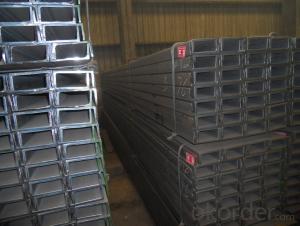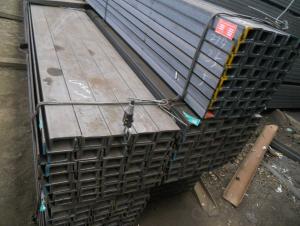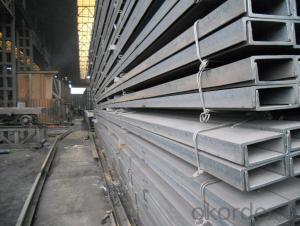Hot Rolled Steel U Channel UPN EN Standard
- Loading Port:
- China main port
- Payment Terms:
- TT OR LC
- Min Order Qty:
- 100 m.t.
- Supply Capability:
- 10000 m.t./month
OKorder Service Pledge
OKorder Financial Service
You Might Also Like
Product Description:
OKorder is offering Hot Rolled Steel U Channel UPN EN Standard at great prices with worldwide shipping. Our supplier is a world-class manufacturer of steel, with our products utilized the world over. OKorder annually supplies products to African, South American and Asian markets. We provide quotations within 24 hours of receiving an inquiry and guarantee competitive prices.
Product Applications:
Hot Rolled Steel U Channel UPN EN Standard are ideal for structural applications and are widely used in the construction of buildings and bridges, and the manufacturing, petrochemical, and transportation industries.
Product Advantages:
OKorder's Hot Rolled Steel U Channel UPN EN Standard are durable, strong, and wide variety of sizes.
Main Product Features:
· Premium quality
· Prompt delivery & seaworthy packing (30 days after receiving deposit)
· Can be recycled and reused
· Mill test certification
· Professional Service
· Competitive pricing
Product Specifications:
Manufacture: Hot rolled
Grade: Q195 – 235
Certificates: ISO, SGS, BV, CIQ
Length: 6m – 12m, as per customer request
Packaging: Export packing, nude packing, bundled
| EN STANDARD CHANNEL (UPN) | ||||||
| SIZE(MM) | h(mm) | b(mm) | s(mm) | t(mm) | kg/m | length |
| 80x45x6x8 | 80 | 45 | 6 | 8 | 8.64 | 6m,12m |
| 100X50x6x8.5 | 100 | 50 | 6 | 8.5 | 10.6 | 6m,12m |
| 120x55x7x9 | 120 | 55 | 7 | 9 | 13.4 | 6m,12m |
| 140x60x7x10 | 140 | 50 | 7 | 10 | 16 | 6m,12m |
| 160x65x7.5x10.5 | 160 | 65 | 7.5 | 10.5 | 18.8 | 6m,12m |
| 180x70x8x11 | 180 | 70 | 8 | 11 | 22 | 6m,12m |
FAQ:
Q1: How do we guarantee the quality of our products?
A1: We have established an advanced quality management system which conducts strict quality tests at every step, from raw materials to the final product. At the same time, we provide extensive follow-up service assurances as required.
Q2: what is the difference between actual weight and theoretical weight?
A2: All the section steel has two weights: actual weight and theoretical weight. Actual weight is the weighing out when the product delivered from the mill. Theoretical weight is calculated by pieces. The invoice can be based on each of them as your request.
Q3: How many tons of steel products could be loaded in containers?
A3: Usually the steel products are delivered by bulk vessel because of the large quantity and the freight. However, there are no bulk vessel enter some seaports so that we have to deliver the cargo by containers. The 6m steel product can be loaded in 20FT container, but the quantity is changed according to the size, usually from 18tons to 25tons.
Images:


- Q:What are the considerations for selecting steel channel sizes?
- When selecting steel channel sizes, there are several considerations that need to be taken into account. These include the load-bearing capacity required for the intended application, the span or distance between supports, the material and weight of the items being supported, and the structural stability needed. Additionally, factors like cost, availability, and compatibility with other building materials may also influence the selection process. Ultimately, the goal is to choose a steel channel size that can effectively support the intended load while ensuring structural integrity and meeting the project's requirements.
- Q:What is the standard length of steel channels?
- The standard length of steel channels can vary depending on the specific industry and application. However, in general, steel channels are commonly available in standard lengths of 20 feet or 6 meters. These lengths are often chosen to facilitate easy transportation and handling, as well as to align with common building and construction practices. It is important to note that custom lengths can also be obtained based on specific project requirements, but the standard length of 20 feet or 6 meters is widely used and readily available in the market.
- Q:How are steel channels used in structural applications?
- Due to their exceptional strength and versatility, steel channels are widely utilized in structural applications. In the construction industry, they are commonly employed to support heavy loads and ensure the structural integrity of buildings, bridges, and other infrastructures. Framing buildings is one of the primary uses for steel channels. They are frequently employed as beams or columns to bear the weight of floors, walls, and roofs. Steel channels are selected for these purposes because they can endure substantial loads without deforming or collapsing. Aside from building frames, steel channels are also employed for bracing and reinforcing structures. They can serve as diagonal braces, providing lateral stability and preventing the structure from swaying or collapsing under wind or seismic forces. Steel channels are also utilized as reinforcement in concrete structures, such as retaining walls and foundations, to enhance their strength and durability. In the manufacturing of machinery and equipment, steel channels play a pivotal role. They provide a stable and rigid framework for heavy machinery, enabling smooth and efficient operation. In this context, steel channels are frequently employed as support beams, frames, or structural components in various industrial applications. Furthermore, the transportation industry also relies on steel channels. They are used in the construction of bridges and overpasses, where their high strength and load-bearing capacity are vital for safely accommodating vehicles and pedestrians. Steel channels are also utilized in the manufacturing of railway tracks and tramways, providing a durable and stable foundation for the transportation system. Overall, steel channels are of utmost importance in structural applications as they deliver strength, stability, and durability to diverse types of constructions. Their versatility and ability to withstand heavy loads make them the preferred choice in the construction, manufacturing, and transportation industries.
- Q:What are the load-bearing capabilities of steel channels?
- The load-bearing abilities of steel channels vary depending on several factors like dimensions, material grade, and the specific application at hand. Steel channels are designed to offer structural support and are commonly utilized in construction and engineering projects. The shape and size of a steel channel significantly impact its load-bearing capacity. The channel's depth, width, and thickness determine its overall strength and ability to endure loads. Additionally, the material grade of the steel channel plays a vital role in determining its load-bearing capabilities. Generally, higher grades of steel possess greater tensile and yield strengths, enabling them to support heavier loads. Engineers typically rely on industry standards and reference tables to precisely determine the load-bearing capabilities of a steel channel. These resources provide guidance on the safe working loads for different sizes and grades of steel channels. When calculating the maximum load a steel channel can bear, engineers also consider factors like the type of loading (e.g., static or dynamic), the support conditions (e.g., fixed or pinned), and the required safety factor. It is important to acknowledge that factors such as the quality of fabrication, the presence of defects or damage, and the overall structural design can also influence load-bearing capabilities. Therefore, consulting a qualified engineer or referring to appropriate design codes and regulations is crucial when determining the load-bearing capabilities of steel channels for a specific application.
- Q:How do steel channels perform in terms of earthquake resistance?
- Steel channels exhibit excellent earthquake resistance due to their shape and design, allowing for effective distribution and dissipation of seismic forces. They possess structural integrity, which enables them to withstand lateral forces, vibrations, and ground accelerations experienced during earthquakes. Furthermore, the ability of steel channels to flex and bend without fracturing aids in absorbing and dissipating the energy generated by seismic activity. This flexibility ensures their stability and prevents structural failure during earthquakes. Hence, steel channels are widely regarded as a dependable and long-lasting option for earthquake-resistant construction, as they can endure and mitigate the impacts of seismic forces.
- Q:Can steel channels be used for bracing purposes?
- Steel channels have a wide range of uses in construction and engineering, including bracing. They are commonly employed to provide structural support and reinforcement. Their strength and durability make them capable of withstanding heavy loads and ensuring stability. Steel channels can be customized and easily installed to meet specific bracing needs. They effectively reinforce various components, preventing buckling, bending, or collapse. In conclusion, steel channels are a dependable and efficient choice for bracing in construction and engineering projects.
- Q:What are the different types of support brackets for steel channels?
- There exists a variety of support brackets suitable for steel channels. Below are some commonly used types: 1. Cantilever brackets: Designed to support the steel channel from one end, allowing it to extend freely without support on the other end. They are often used when the steel channel needs suspension or when space is limited for traditional support brackets. 2. L-shaped brackets: Basic and commonly used support brackets for steel channels. They have a 90-degree angle shape, with one side attached to the wall or structure, and the other side supporting the steel channel. L-shaped brackets provide stability and are ideal for securely fixing channels to walls or surfaces. 3. U-shaped brackets: Also known as pipe hangers or pipe clamps, these brackets support steel channels carrying pipes or tubes. The U-shaped design securely holds the channel, providing stability and preventing movement or vibration. They are commonly used in plumbing, HVAC, and electrical installations. 4. Angle brackets: Designed to support steel channels at an angle, these brackets are often used when channels need to be mounted diagonally or require additional support to withstand heavy loads or forces. They are adjustable to different angles, making them versatile for specific installation requirements. 5. Strut brackets: Specifically designed for steel channels within a strut system, these brackets are typically made of metal and have holes or slots for secure attachment. They offer flexibility and adjustability, allowing easy repositioning of the channel as needed. When selecting a support bracket for steel channels, it is essential to consider the specific requirements of your application. Factors such as load capacity, installation method, and environmental conditions should be taken into account to ensure proper support and stability for the steel channel.
- Q:What is the square bevel washer used for channel steel?
- Two dimensional software Qinghua Qinghua Tianhe CAD is a coincidence. You can also check the size according to the national standard.
- Q:How do steel channels perform in high-vibration environments?
- Steel channels are known for their excellent strength and durability, making them suitable for various applications, including high-vibration environments. In such environments, steel channels perform exceptionally well due to their inherent properties. Firstly, steel channels have a high tensile strength, allowing them to withstand significant vibration forces without deforming or breaking. This strength is crucial in high-vibration environments where constant motion and mechanical stress are present. The robust nature of steel channels ensures their ability to handle the vibrations effectively. Moreover, steel channels have excellent damping characteristics, meaning they can absorb and dissipate energy from vibrations. This property helps to minimize the impact of vibrations on the overall structure or equipment. By reducing the amplitude of the vibrations, steel channels contribute to maintaining stability and preventing potential damage or failures. Additionally, steel channels can be designed and manufactured to meet specific requirements, allowing for customization based on the intensity and frequency of the vibrations. This flexibility in design enables engineers to select appropriate dimensions, cross-sections, and configurations to optimize the performance of steel channels in high-vibration environments. Furthermore, steel channels are highly resistant to corrosion, which is particularly important in environments where moisture, chemicals, or other corrosive agents may be present. Corrosion can weaken the structural integrity of any material, but steel channels are able to retain their strength and performance over extended periods, even in harsh conditions. In summary, steel channels are well-suited for high-vibration environments due to their high tensile strength, excellent damping characteristics, design flexibility, and corrosion resistance. These qualities make steel channels a reliable and efficient choice for applications in industries such as construction, infrastructure, transportation, and manufacturing, where high-vibration environments are common.
- Q:How do you mark the types of steel such as channel, I-beam and so on in the document?
- Like the board, tube, and so on, right click on the Greek character mother with the keypad of the input method, and then choose.The thickness of the plate said.Phi means the diameter of the tube.H section steel, it is direct capital letters, H said in front of the good.A worker is a worker..Angle is digital symbols with small keyboard input method to select right angle of mathematical symbols.The slot is the keypad of the input method. Right click on the punctuation mark.By analogy.....
1. Manufacturer Overview |
|
|---|---|
| Location | |
| Year Established | |
| Annual Output Value | |
| Main Markets | |
| Company Certifications | |
2. Manufacturer Certificates |
|
|---|---|
| a) Certification Name | |
| Range | |
| Reference | |
| Validity Period | |
3. Manufacturer Capability |
|
|---|---|
| a)Trade Capacity | |
| Nearest Port | |
| Export Percentage | |
| No.of Employees in Trade Department | |
| Language Spoken: | |
| b)Factory Information | |
| Factory Size: | |
| No. of Production Lines | |
| Contract Manufacturing | |
| Product Price Range | |
Send your message to us
Hot Rolled Steel U Channel UPN EN Standard
- Loading Port:
- China main port
- Payment Terms:
- TT OR LC
- Min Order Qty:
- 100 m.t.
- Supply Capability:
- 10000 m.t./month
OKorder Service Pledge
OKorder Financial Service
Similar products
New products
Hot products
Related keywords





























